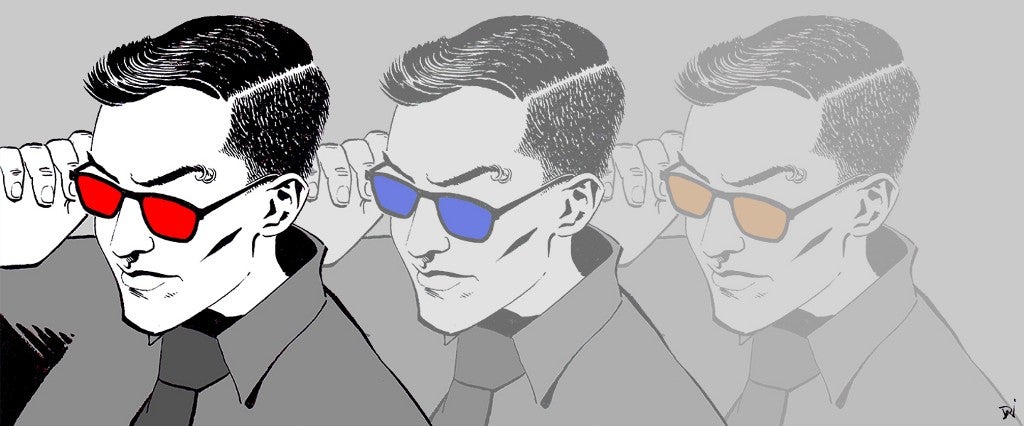Have you ever seen The Birdcage? There’s this scene, early on, when Armand Goldman (played by Robin Williams) is trying to teach his husband Albert (played by Nathan Lane) to pass as straight. They’re working on walks, and Armand suggests that Albert try walking like the unimpeachable pinnacle of straight masculinity: John Wayne.
Albert dons his hat with a flourish, hitches up his pants, and makes his way across the floor in a weird, lopsided prance, as Armand gapes.
“No good?” Albert asks.
“Actually, it was perfect,” Armand tells him. “I just never realized John Wayne walked like that.”
When you’re a transgender man — especially one who came out well into adulthood — cracking the cipher of masculinity takes on new urgency. D.I.Y. gender is meticulous, obsessive. We pry that shit open, unpack and catalogue it like archaeologists at a dig: how to dress, how to stand, how to talk, how to pee. We track regional variations, practice walks. We study men’s magazines and FtM resources like Hudson’s Guide as if they’re bibles.
Those excavations feel like traps and treasure maps at the same time. On one hand: I’m hopeful that somewhere hidden in the intricacies of these rules is the trail to an authentic self that I never before had the wherewithal to assemble.
On the other hand: When you have something to prove — and oh, god do I ever — it’s a steep and slippery slope from description to prescription, from “Men often do this” to “You must do this in order to be a man.” The stakes of deviating from social norms become exponentially higher, and exploration veers toward compulsion. No one maps the landscape of manhood more carefully than transmen, and no one falls harder into its traps of toxic masculinity and defensive misogyny.
It’s a bit of a balancing act — not so different from trying to walk like John Wayne.
The fairy tale of transition is one of whole-cloth transformation, a butterfly emerging fully formed from the cocoon of its previous self. If not that, it’s a story of linear progression: a series of steps toward an endgame of becoming the person you’ve always known yourself to be.
Sometimes, it’s true. There are people who just know, who’ve always known; who have a true self poised to emerge, or for whom every step moves them further on a clear path from point A to point B.
I’m not one of them.
My experience of transition has been one of continual second-guessing. I’m tiptoeing into manhood like a cold ocean. I change my name by degrees, a breadcrumb trail of bylines, from Rachel, to Jay Rachel, to Jay. I make excuses, file away the surgeon’s letter that will let me change the gender marker on my driver’s license until I’ve figured out what to do with my middle name. I cling to the middle ground of neutral pronouns; to the word transmasculine and its implication of direction rather than destination.
After 30 years spent trying and failing to get the hang of being a woman, I find myself somewhat unprepared for the sudden challenge of being a man — and acutely aware of just how instinctual most of it isn’t. It’s pornography, or John Wayne’s walk: difficult to quantify, recognizable mostly in its presence — or its absence.
For instance: Testosterone will deepen my voice, but when it comes to sounding like a guy, research shows that depth matters less than inflection. Dressing like a man and dressing to make a feminine body read as male overlap less than you’d think. The logistics of using a urinal when I lack the recommended plumbing are a hell of a lot less complicated than navigating the etiquette of men’s bathrooms, where the unwritten rules of manhood are at their most intricate and rigid, and the stakes at their highest.
And with all of this come the kinds of questions that don’t really have right answers. How much of myself am I compromising to fit a standard of masculinity I recognize as constructed? Does acknowledging that identity as constructed make it any less real?
Also, the shirts all button on the other side.
So: I’m learning to be a guy.
And I’m trying my best to do it carefully—because it’s big, and because it’s important, and because it’s me. Because after a life and career spent challenging and deconstructing gendered barriers, I don’t want to transition from one constrictive box to another, even if the second one is a more comfortable fit.
I don’t want to walk like John Wayne. I want to walk like me — but first, I have to I figure out what that means.
How to Be a Guy is part social deconstruction, part personal cartography. I’ll be exploring the complicated straits of masculinity and identity, from the prosaic to the esoteric — menswear; marriage; the social dynamics of Ninja Turtles; and, yes, probably even the bathroom thing — as I learn to navigate gendered spaces from beaches to bedrooms and try to define my manhood on my own terms.
Jay Edidin is a Portland-based writer whose work has appeared in Playboy and Wired. ‘How to Be a Guy’ is their column for MEL.
- Families Transition, Too
- Families in Transition, Part V: Father & Son
- Families in Transition, Part III: Brother & Sister
